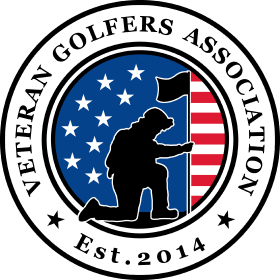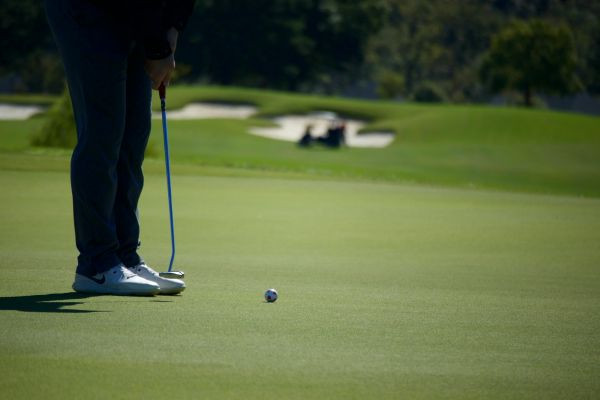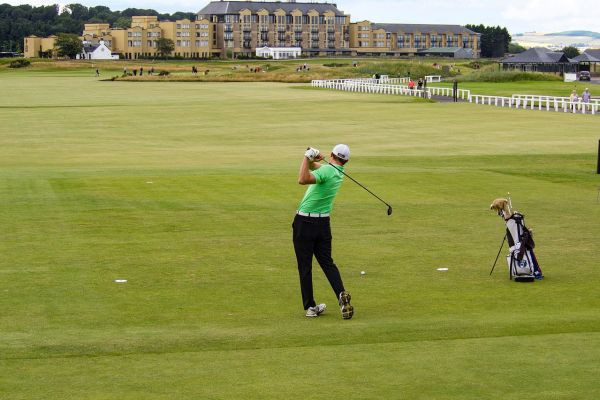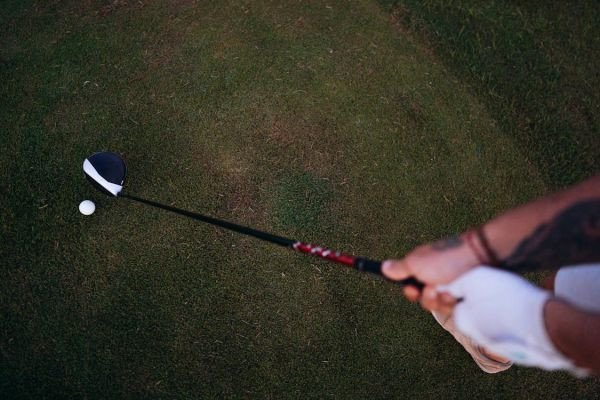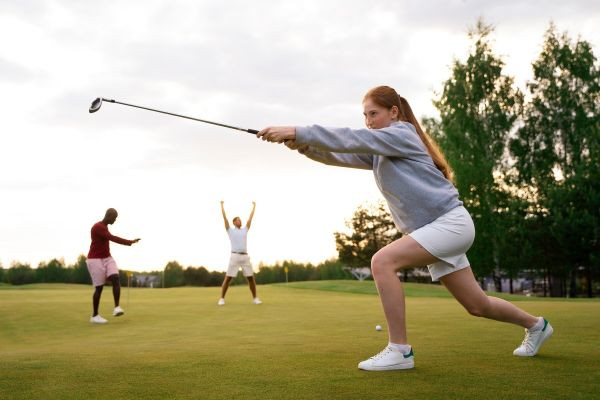Overcoming the Chicken Wing in Golf
The term "chicken wing" in golf refers to a common flaw in the swing where the lead arm (usually the left arm for a right-handed golfer) bends at the elbow post-impact, resembling a chicken wing. This..

The term "chicken wing" in golf refers to a common flaw in the swing where the lead arm (usually the left arm for a right-handed golfer) bends at the elbow post-impact, resembling a chicken wing. This bending action typically results in a loss of power and inconsistent shots.
The chicken wing hampers your swing's efficiency, leading to reduced distance, accuracy issues, es, and overall inconsistent performance. Overcoming this flaw is crucial for any golfer looking to improve their game.
The Root Causes of the Chicken Wing
Lack of Hip and Body Rotation
Insufficient rotation of the hips and body, during the golf swing is a reason why people end up with a chicken wing. Many amateur golfers overlook the significance of body movement in driving their swing, which leads to this problem. In a swim, the hips and torso should work together creating a powerful motion that results in a strong impact.
When there is limited or no rotation it puts pressure on the arms, particularly the lead arm. This often causes a bend at the elbow after impact known as the chicken wing. The body tries to compensate for the lack of support from the body by bending the arm to maintain control over the clubface and aim at the target. However, er this compensation diminishes efficiency in both power and control of the swing.
To improve hip and body rotation it's important to focus on enhancing flexibility and strength in your core and lower body. Incorporating exercises that increase the range of motion and muscular control in these areas can make a difference, for golfers.
Moreover, er it is crucial to practice the technique of rotation to ensure that the entire body, rather than just the arms, propels the golf swing.
v
Overdependence on Arms and Hands
One of the reasons for the chicken wing phenomenon in golf is when players overly rely on their arms and hands during their swing. This is often seen in self-self-taught inner golfers who prioritize using their arms to generate speed and control the club, disregarding the role of the body in creating a powerful swing.
Relying too much on the arms brings about issues. Firstly it limits the amount of power generated in the swing since relying on the arms cannot match the force produced by engaging the body. Secondly, this approach often leads to a loss of control and consistency as managing both club trajectory and face angle becomes more challenging without the engagement of the body.
To address this problem golfers should focus on understanding and practicing how to involve their body in their swing. This includes not only utilizing their arms and hands but also incorporating movements, from their shoulders, h, hips, and legs. Engaging in drills that emphasize synchronizing lower body movements can be especially beneficial.
By mastering the use of the body golfers can minimize their reliance on their arms and hands hence avoiding the chicken wing and enhancing their swing mechanics.
Step-by-Step Guide to Correcting the Chicken Wing
Understanding the Power Turn
The Power Turn is an element of a golf swing involving a complete and fluid rotation of the body during both the backswing and an unfollow-through. Mastering this technique is crucial for eliminating the chicken wing.
The Power Turn ensures that the energy and momentum generated in the swing originate from the core of the body rather than solely relying on arm movement. This comprehensive rotation of the body helps maintain balance and rhythm throughout the swing resulting in a consistent and powerful impact. Golfers should focus on rotating their shoulders during the backswing while allowing their hips to lead during the downswing thus creating an efficient motion.
Hip Extension and Rotation Drills
To rectify issues with the chicken wing technique it is essential to practice hip rotation and extension. These drills aim to enhance flexibility and strength in hip joints enabling range of motion while facilitating transfer of power throughout each swing.
One helpful exercise involves inserting an alignment stick or a golf club through the belt loops and practicing rotating the hips while keeping the alignment stick in sync with the swing. This visual aid assists golfers in grasping the degree of hip rotation and encourages an engaged lower body during the swing. Regularly practicing these drills develops muscle memory for a swing where the hips and body take charge reducing reliance on arm strength for power.
The Role of the Shoulders and Arms
Understanding how the shoulders and arms interact with the rest of the body is crucial to address any issues with a chicken wing. Effective shoulder rotation in conjunction with body movement allows for natural extension of the arms during each swing. This coordination ensures that arm movement is not compensating for body motion but instead complements body rotation.
Golfers should focus on maintaining their leading shoulder beneath their chin during the backswing and allowing it to move naturally with their body’s rotation during the downswing.
Creating space for the arms to fully extend and avoiding the folding or bending motion of a chicken wing is crucial in this technique
Practicing the Straight-Line Release
To achieve a proficient swing it is important to master the straight line release. This involves keeping a line from your leading shoulder to the club head at impact and a little beyond. Practicing this release helps prevent the elbow from bending into a chicken wing position.
One effective drill is to concentrate on extending your arms towards the target after impact, envisioning a line being drawn with your club. This extension promotes natural follow-through, which is essential for generating power and accuracy in your golf swing.
Essential Drills for Eliminating the Chicken Wing
Alignment Stick Drill for Hip Rotation
Use an alignment stick through your belt loops. Practice rotating your hips to achieve opening at impact. This drill emphasizes hip rotation, which plays a role in overcoming the chicken wing.
Shoulder Positioning and Extension Exercises
Focus on exercises that encourage shoulder positioning and extension.
By incorporating these drills into your practice routine you can effectively eliminate the chicken wing motion and will improve your golf swing technique. These exercises assist in providing room for an extension of the arm while performing the swing.
Common Mistakes and How to Avoid Them
Avoiding Over-the-Top Swings
One of the most prevalent issues that contribute to the chicken wing is the over-the-top swing. This occurs when a golfer starts the downswing with the upper body or shoulders, causing the club to move outside the intended swing path, leading to a steep and choppy swing. This motion not only encourages the chicken wing but also often results in slices or pulls.
To avoid over-the-top swings, golfers should focus on initiating the downswing with their lower body. A useful drill is to practice delaying the upper body movement at the start of the downswing, allowing the hips and legs to lead.
This approach helps in creating an inside-out swing path, where the club approaches the ball from inside the target line, promoting a more fluid and natural extension of the arms. Visual cues, like imagining swinging out toward the s the right field for a right-handed golfer, can also be effective in training the body to adopt this more desirable swing path.
Ensuring Proper Arm Extension
Another common issue is the failure to fully extend the arms through the golf swing. This lack of extension not only reduces power and accuracy but is also a key factor in developing the chicken wing. Full arm extension is critical for a powerful, controlled swing and helps ensure a solid impact with the ball.
Practicing drills that focus on arm extension can be highly beneficial. One effective drill is the towel under the arm drill. By placing a towel under the lead arm (the left arm for a right-handed golfer) and keeping it in place throughout the swing, golfers can train themselves to maintain better arm-body connection, which naturally encourages full arm extension.
Golfers should also focus on extending their arms towards the target in the follow-through, ensuring that both arms are straight and the body is fully rotated towards the target in the finishing position. This not only helps in achieving a more consistent swing but also prevents the arms from bending into a chicken wing.
Advanced Techniques for Refining Your Swing
Incorporating Flexion and Extension
Understanding and effectively implementing the relationship between flexion (bending) and extension (straightening) in your swing is a critical advanced technique for refining your swing. Flexion primarily occurs during the backswing as you bend your body and elbows to create a compact, powerful position. Extension happens in the downswing and follow-through, where your body and arms straighten, transferring energy into the ball.
To work on transitioning smoothly between these two states, focus on drills that emphasize the full range of motion in your golf swing. One effective drill is the 'L to L' drill, where you practice swinging from a position where your arms form an 'L' shape in the backswing to another 'L' shape in the follow-through.
This helps in understanding the right amount of flexion and extension needed at various points of the swing. Additionally, using video analysis to study your swing can be invaluable in identifying areas where your flexion and extension can be improved.
Full Finish and Balance Drills
Achieving a full finish with proper balance is essential for a powerful and accurate golf swing. A complete finish ensures that you have transferred your weight effectively through the swing and is a good indicator of proper swing mechanics.
Improving your swing can be achieved by incorporating drills that emphasize finish and balance. One effective drill involves practicing your swing and holding the finishing position for three seconds. During this drill make sure to shift your weight onto your front foot, face the target with your bo,dy, and point your foot toward the sky. This exercise not only helps develop a balanced finish but also trains your body to complete the swing, with full extension reducing the chances of a chicken wing.
Bringing It All Together
Combining Drills for a Fluid Swing
To achieve an efficient swing without a chicken wing it is essential to integrate drills into your practice routine. The key is to create a practice plan that addresses all aspects of the swing from the backswing to the o follow-through.
Incorporating drills that focus on hip rotation, shoulder alignment, arm extension, and completing the finish will gradually instill proper movement patterns into muscle memory. This will result in an effective swing over time.
Tips for Consistent Practice
Consistency in practice plays a role, in eliminating the chicken wing and enhancing golf performance.
Make sure to set time for focused practice sessions and stick to a consistent routine. It's not only about the amount of practice but also the quality.
Ensure that each drill is performed with attention to detail and regularly assess your progress either by yourself or with the guidance of a coach. Remember, small improvements over time can result in changes.
Frequently Asked Questions (FAQ)
What is the chicken wing in golf?
Ingo, the term "chicken wing" refers to a swing flaw where the lead arm (the arm for right-handed golfers) bends at the elbow, particularly after hitting the ball. This bending creates a resemblance to a chicken wing, the name. This issue usually occurs when there is poor coordination and inadequate rotation in the golfer's swing leading to a reliance on arm movement rather than utilizing the entire body for power.
Why is avoiding the chicken wing important?
Avoiding a chicken wing is crucial for several reasons.
Firstly it allows golfers to maximize their swing power by engaging all parts of their body including core and lower body muscles, instead of relying on their arms. Secondly having an arm extension during the swing is crucial for improving shot accuracy and consistency. It allows control of the clubface. Helps determine the direction of your shot. Furthermore, by avoiding the chicken wing in your swing you can minimize the risk of strain or injury. This is because it encourages an efficient movement of your body throughout the swing.
How can I tell if I have a chicken wing in my swing?
You can assess your swing through video footage. Seek guidance from a golf instructor. When analyzing your swing pay attention to the position of your arm during and after impact. If you observe bending and tucking of the elbow towards your body forming an angle resembling a chicken wing then it's likely that you're dealing with this flaw in your swing.
What drills can help eliminate the chicken wing?
Some drills can effectively help eliminate the chicken wing from your swing. Among them are hip rotation drills that emphasize lower body turning. This technique aids in leading the swing while reducing reliance on arm movements.
Sure incorporating arm extension drills into your golf practice, such as focusing on keeping your lead arm throughout impact can be helpful.
Can the chicken wing affect my overall golf performance?
The chicken wing can have an impact on your overall golf performance. It usually leads to reduced power since it restricts the extension of your arms and hinders optimal body movement during the swing. This can result in shorter driving distances and difficulty controlling shot direction and trajectory. Additionally having a chicken wing in your swing can cause inconsistency in shots. Make it challenging to maintain a game. Over time it may even contribute to strain or injury due to the arm position.
Is it possible to completely get rid of the chicken wing?
Absolutely! With practice and applying techniques you can eliminate the chicken wing from your swing. It's important to understand the mechanics of a golf swing and focus on drills that specifically address areas needing improvement. Remember, changing swing habits takes time so be patient and persistent.
